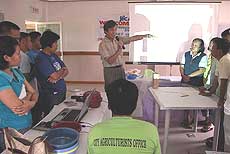The problems of food
 |
| Children eating fortified food at a nutrition care center in Niger run by "Medicines Sans Frontiers." (2007, photo provided by MSF©Anthony Jacopucci/MSF) |
Around the world, about 25,000 people die of starvation every day. According to the United Nations World Food Program (WFP), a child dies of starvation every six seconds. It is a reality that is hard to imagine for those of us who live in Japan.
For this issue, the junior writers investigated the facts behind food problems in the world. We found that starvation is caused not only by conflict and natural disasters, but also by the unfair distribution of farm produce. As well as being linked to the natural environment, food problems are tied to economic issues, which is probably why finding a solution is not such a simple matter.
We interviewed some Japanese people who have worked tirelessly to reduce starvation by delivering food aid or teaching agricultural skills to increase food production.
We guess most of you know there are people suffering from hunger in the world. We hope you will try to imagine what it would be like if you were one of them, or if they were your children.
Situation in the world
850 million people lack adequate food / One child dies every six seconds
In the world today, about 850 million people suffer from a lack of food. According to the United Nations World Food Program (WFP), one child under the age of five dies of hunger every six seconds in Africa, South Asia, and other regions.
On the other hand, the Japanese Ministry of the Environment calculates that in Japan around 20 million tons of food is thrown away each year.
Prof. Izumi Fujita, 60, of the Life and Environmental Science faculty at the Prefectural University of Hiroshima, is an expert in agricultural economics. He explained to us that the economic system focuses on the food requirements of the developed countries, and the recent rise in food prices exacerbates the situation.
The rise in the price of food is caused by several factors. One is the increase in "speculative money" that is used to buy and sell grain in order to make a profit. Another reason is that Australia, a wheat exporting nation, was struck by a series of droughts that resulted in a large drop in wheat production. Moreover, as an alternative to oil, soybeans and corn are being used for the production of biofuels and this in turn is affecting the consumption of grain.
In Africa and other parts of the world that were formerly colonized, the economic tendency is to concentrate on producing cash crops such as cotton or coffee for export, which often leaves them unable to produce sufficient food for their own domestic consumption.
Prof. Fujita points out that peace is the most important precondition for creating stable crop yields. Selective breeding of crops is also important. For example, NERICA (New Rice for Africa), which is resistant to insect damage and produces greater yields than standard crops, is being produced with assistance from Japan and other countries.
To combat speculative investing, Prof. Fujita proposes that when food prices rise above a certain level, part of the profit should be used to help alleviate food shortages. (Shotaro Takata, 14)
Situation in South Asia
30% of the populations of India, Nepal, and Bangladesh suffer from malnutrition
We spoke with Prof. Keshav Lall Maharjan, 49, who specializes in rural economics at Hiroshima University Graduate School for International Development and Cooperation. We asked him about food problems in South Asia. He has conducted field research in India, Nepal, and Bangladesh and found that almost 30% of the populations in these countries are unable to get adequate nutrition.
The reasons differ from nation to nation. In Nepal and India, the caste system and high population growth combine to create a major impact on the food problem. For the lower castes it is almost impossible to find a good job and own land, which makes it difficult for them to get enough food. In Nepal, the population has almost doubled in the last 30 years.
In Bangladesh, floods are often caused by cyclones and monsoons and serious damage occurs when floodwaters wash away crops.
"Assistance from overseas is indispensable," said Prof. Maharjan, "but the circumstances of the recipient should be considered as well as the necessity of preserving the independence of the country being assisted." (Ryota Matsuda, 14)
| Click to watch our interviews with Prof. Maharjan and Prof. Fujita. |

The United Nations World Food Program (WFP) is an international organization that specializes in food aid. In 2007, WFP provided 330 tons of food to 86.1 million people in 80 countries in Africa, Asia, and Central America. Japan donates $129,000,000 a year to WFP and is the world's third largest contributor. Kenro Oshidari, 52, (photo provided by WFP) has worked as the regional director of the Sudan office since 2006. In Sudan, although a Comprehensive Peace Agreement was signed in 2005 to end more than 20 years of civil war, conflict broke out again in Darfur in the west of the country in 2003 and still continues today. This conflict has resulted in more than two million people being displaced and living in refugee camps. According to the United Nations Food and Agriculture Organization (FAO), a quarter of Sudan's population of 40 million suffers from malnutrition and 2,800 WFP personnel are distributing sorghum, wheat, salt, and beans to five million people. WFP also provides school lunches. Mr. Oshidari told us that education is the first step away from poverty and seeing the children heartily tucking into their lunch makes him feel glad to work for WFP. The biggest problem WFP faces is a lack of security. As many as 100 WFP trucks carrying food have been attacked and two drivers have been killed since the beginning of this year. (Risa Kushioka, 17)

Hunger Free World (HFW) is an NPO that provides nutrition and sanitation-related assistance in four different countries. We sent an email to Toko Tomita, 31, (photo provided by HFW), who is in charge of operations in Benin and Burkina Faso. In both countries there has been little rain recently so sufficient crop yields cannot be guaranteed. Moreover, in both countries, men have a lot of power and at meals they get to eat first, while children are left with insufficient food. In Benin, HFW teaches people how to process a local staple crop called cassava to augment their income. In Burkina Faso, HFW carries out nutritional check-ups on babies and small children, and provides treatment and advice. One day an undernourished child who was being treated suddenly stopped coming and died a few weeks later. The child's mother felt unable to tell her husband about the state of the child's health and could not take the child to the clinic because her husband forced their children to work in the fields. Ms. Tomita told us that although material supplies are needed, it is far more important, but more difficult, to change people's way of thinking and awareness. (Seira Furukawa, 15)
The Japan International Cooperation Agency (JICA) undertakes agricultural skills training in about 30 countries in order to increase food production and farmers' incomes. In the Philippines, JICA has been assisting the Philippine Rice Research Institute since 1992 in an effort to increase rice yields. Nobuyuki Kabanoki, 58, the project leader, has a wealth of experience in rice planting research at a Ministry of Agriculture, Forestry and Fisheries research center in Japan. He taught agricultural technology for about 10 years in Thailand, Vietnam, and other countries. Farmland in the Philippines is scarce and it appears difficult to expand the amount of land available for farming. With the population increasing at a rate of more than 2% a year, current rates of food production cannot keep up with this population growth. However, in the year 2000, the crop yield per hectare was 3 tons, less than half that of Japanese yields so efforts are being made to improve productivity. Mr. Kabanoki teaches agricultural skills to governmental officials of villages and ambitious farmers in cities, towns, and villages on Luzon Island. His aim is to share skills that can by actively applied with the aim of achieving self-sufficiency in farming rather than merely providing temporary support. (Shiori Kosaka, 13)
A "food bank" receives food from merchants that is approaching the expiration date and would otherwise be thrown away then distributes this food free of charge to those in need. This kind of initiative has become more widespread in Japan since the first food bank was started about 10 years ago and there are now food banks in Tokyo, Kobe, Hiroshima, and other places. The group active in Hiroshima is called "Aiai Net." They receive soup and vegetables from six manufacturers and distributors, and deliver parcels of food to six institutions, including homes for the handicapped and the elderly and centers for mothers and children. The leader of the group, Yoshiko Harada, 56, explained that she started the activity because she felt she had to do something about the amount of good food that was being thrown away. I think this is very meaningful work since the institutions that receive the food can save money and buy other necessities for the people they serve. (Seira Furukawa, 15)
Oxfam Japan is an NGO that seeks to influence leaders in developed countries to pursue solutions to poverty and related problems. This kind of campaign is called "advocacy" and we interviewed Akiko Mera, 40, the executive director of Oxfam Japan, about her work. The aim of advocacy is to create opportunities to voice concerns as voters and consumers, thereby persuading politicians to take action. One of Oxfam Japan's successes involved the G8 Summit in 2005, at which they helped convince world leaders to commit to forgiving the debts of 42 developing countries. In order to have an impact on such leaders, it is important to motivate citizens and rouse public opinion. Ms. Mera believes that advocacy becomes effective when people realize that, in joining together for a common purpose, their voices can change the world. In this way, I think it's possible for us to do something about the food problems in the world. (Daishi Kobayashi, 16) |
